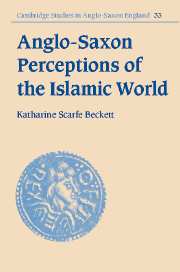Book contents
- Frontmatter
- Contents
- Acknowledgements
- List of abbreviations
- 1 Introduction
- 2 Islam during the Anglo-Saxon period
- 3 Anglo-Saxon contacts with Islam
- 4 Arabs and Arabia in Latin
- 5 Ismaelites and Saracens in Latin
- 6 Arabs, Ismaelites and Saracens in early Anglo-Latin
- 7 Pseudo-Methodius and the sons of Ismael
- 8 Arabs, Ismaelites and Saracens in Old English
- 9 Persisting theories about Saracens in post-Conquest England
- 10 Conclusions
- Bibliography
- Index
6 - Arabs, Ismaelites and Saracens in early Anglo-Latin
Published online by Cambridge University Press: 22 September 2009
- Frontmatter
- Contents
- Acknowledgements
- List of abbreviations
- 1 Introduction
- 2 Islam during the Anglo-Saxon period
- 3 Anglo-Saxon contacts with Islam
- 4 Arabs and Arabia in Latin
- 5 Ismaelites and Saracens in Latin
- 6 Arabs, Ismaelites and Saracens in early Anglo-Latin
- 7 Pseudo-Methodius and the sons of Ismael
- 8 Arabs, Ismaelites and Saracens in Old English
- 9 Persisting theories about Saracens in post-Conquest England
- 10 Conclusions
- Bibliography
- Index
Summary
Bede wrote of Theodore and Hadrian in his Historia ecclesiastica as learned teachers from Tarsus and Africa who, in the well-known description, poured the waters of wholesome knowledge into the minds of their students day by day. Concerning the lives of Theodore and Hadrian before they came to England, Bede is silent but recent scholarship has supplied the details. Theodore of Tarsus (602–690) spent the 660s and perhaps earlier years as an Oriental monk in Rome. Before this period, he was probably educated in Antioch and possibly in Edessa. If he was still in Syria in the year 636, Theodore may have been forced to leave by the Arab conquests. Hadrian (c. 630–709) was probably a native of Cyrenaica, in Libya. His move to Naples, where he became a monk, may well similarly have been prompted by the Arab invasions of Cyrenaica between the years 642 and 645. These two men thus represent a rare possible contact between England and the Islamic world during its earliest formation.
Theodore came to England from Rome in 669 to oversee the new archiepiscopal see of Canterbury. He had been appointed to this post a year previously by Pope Vitalian (657–72) at the suggestion of Hadrian, at that time abbot of a monastery near Naples. Hadrian had in fact been Vitalian's first choice for the archbishopric when it fell vacant. After he had recommended Theodore for the position, Hadrian too came to England as Theodore's companion and colleague, probably arriving the following year.
- Type
- Chapter
- Information
- Anglo-Saxon Perceptions of the Islamic World , pp. 116 - 139Publisher: Cambridge University PressPrint publication year: 2003

